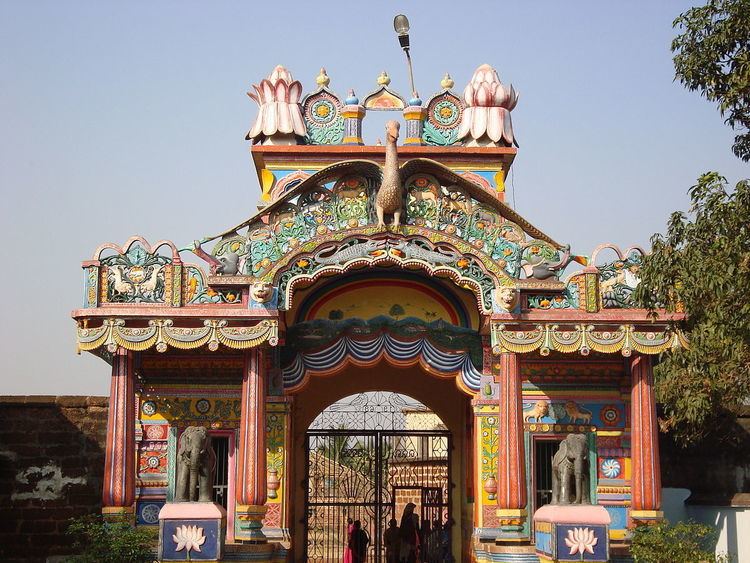Classification Indian religion | Theology Faith in Alekh Headquarters Mahima Gadi | |
 | ||
Founder Prabuddha Guru Mahima Swamy Origin 1862 CE (after Mahima Swamy attained siddhi)Kapilas Hill | ||
Mahima Dharma is an Indian religion practiced primarily in Odisha and nearby states. It was started by people from the underprivileged castes in a caste-based Hindu society as a social reform and protest against the dominance of Brahmanism. The religious movement was based on the condemnation of all religious customs set by the rich and upper-class society generally.
Contents
Founder
The founder of Mahima Dharma was Mahima Swami, or Mahima Gosain as he was also called. The first known report of Mahima Swamy's existence was in 1867 in the newspaper Utkala Deepika in Orissa.
For many years, Mahima Gosain was in deep meditation in the caves at Himalaya. From there, Swami travelled to many regions and at last appeared in Puri (Odisha) in 1826 as Dhulia Gosain, where Swami settled on the dusty roads of Puri. People used to ask him queries on their well being and, surprisingly, it all happened to be true. It is believed once Swami was invited to Puri Mukti Mandap and there he confirmed Brahma is Nirguna and Sunya.
From Puri Swami moved to hill caves of Khandagiri, Dhauligiri, Nilagiri etc. near Bhubaneswar (capital of Orissa state). During that period Swami lived on water alone for twelve years and people used to call him Nirahari Gosain. In 1838, Swami moved to Kapilash hill of Dhenkanal district of Orissa and spent twenty-one days in Atma Yoga Samadhi (unification of human mind) with balkal of the kumbhi tree (bark of careya arborea), leaving his clothes on a huge round stone. A great seven-hooded snake spread its hood covering his head. The nearby area of the forest was illuminated by the luster of the body of Swami. On the 21st day, a tribal, Sadananda of nearby Deogram village, witnessed the magnificent Atma Yoga Samadhi of Swami and served him fruits for twelve years during the stay of Swami at Kapilash hill. For this, Swami came to be known as Phalahari Gosain. The next twelve years Swami survived on cow's milk alone, rendered as service by the ruler of Dhenkanal, King Bhagirathi Bhramarbar Bahadur. Both the king and the queen had the opportunity to witness Swami on top of Kapilash hill and would serve him milk in new earthen pots.
Later, Swami moved to Kakanpada village of Rairakhol with his first disciple Sidha Govinda Baba. It is said he made an appearance to a blind Bhima Bhoi and blessed him with eyesight. Upon seeing the Swami, Bhima, with all his humbleness, prayed to the Swami to make him blind again as the torture of mankind was intolerable for him. Swami blessed him to compose a poem on Nirguna Brahma to spread the Mahima cult. After this, Swami retired back to Kapilash hill. Many believe the journey of Swami to Rairakhol was through air, not by foot.
After spending twelve years in Kapilash hill, Mahima Prabhu travelled around for twenty-four years as Brahmabadhuta (wandering mendicant of supreme order) and spread Mahima Dharma in Odisha and the neighboring states, before taking Samadhi at Joranda, Dhenkanal, of Odisha on the 10th day after the new moon of 1876. The place where Mahima Swami disappeared (merged Himself in the Mahanityapura) is called Mahima Gadi. It is the heart of all Mahima movement around world.
Beliefs
Mahima Dharma teaches belief in a single God (parambrahma or the supreme-soul who is formless and omnipresent) named Alekha.
Mahima Dharma became a powerful force for liberation in India because, as a traditional Indian religion, it stood uncompromising in its rejection of the caste system. Sri Bhima Bhoi, an initiate and ardent disciple of Mahima Swama who collected, disseminated and created bhajans from the teachings of Mahima Swamy, was a Khond from Odisha.
The distinct and original teachings of Mahima Dharma are often conveyed using terms that may have an unrelated meaning in other Indian religious traditions. This has led scholars to see similarities between Mahima Dharma and, variously, the traditions of "crypto-Buddhism", Panchashakas, Jainism and Tantra .
Adherents reject idol worship as well as the Advaita tradition of Vaishnavism. Charity through the provision of food for those in need is an essential part of Mahima Dharma.
Practices
The religion is essentially monotheistic in nature. Mahima religion strictly opposes the caste system and idol worship. The religion strictly forbids adultery, the consumption of any intoxicants, violence, and the consumption of any flesh. Food and water has to be taken before sunset. The Mahima devotee should leave his/her bed around 4am early morning and perform Saran/Darsan before sunrise. Saran/Darsan is the act of complete surrender of self to Mahima Prabhu. The same is repeated three times a day including noon and evening before sunset. They are sometimes misinterpreted as followers of Surya, the Sun god, which is not true.
The religion has a monastic order. Members of the monastic order, like Buddhist monks, do not constitute a priestly class and have no control over the lay practitioners. They have to lead a life of poverty, celibacy, piety and constant movement, as the monks are not allowed to sleep in the same place on two consecutive nights nor take meal twice from same house in any day. There is strict order of the Mahima Swami to avoid any kind of idol worship. The Supreme Lord of the indescribable grace (Alekha) is worshiped.
The Mahima principle is derived from Veda and Upanishads. It is believed by scholars that this might be a neo-Vedanta movement. In short, Mahima cult is a revivalism of the Vedantic thrust and a reformist movement of Odisha within the Sanatan Hindu fold.
